Derrick The Deathfin – Review
by Edward
|
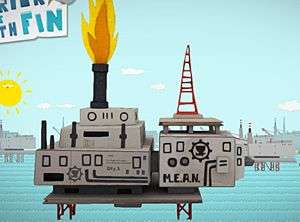 When I was significantly younger than I am now, a singing lobster once imparted his wisdom upon me, with a musical assurance that “Darling it’s better, down where it’s wetter, take it from me”. As it turns out, you shouldn’t trust everything you hear from a crooning crustacean, as I discovered when I reviewed Deep Black: Reloaded earlier this year. Enticed by the promises of innovative underwater combat, I was left with a title more disappointing than a Disney straight-to-video sequel. I prepared to disregard the advice of all lyrical animals until I was introduced to Derrick the Deathfin, a PSN exclusive that aimed to put the “fun” back into “fundamentally, this is a game that primarily takes place underwater”.
When I was significantly younger than I am now, a singing lobster once imparted his wisdom upon me, with a musical assurance that “Darling it’s better, down where it’s wetter, take it from me”. As it turns out, you shouldn’t trust everything you hear from a crooning crustacean, as I discovered when I reviewed Deep Black: Reloaded earlier this year. Enticed by the promises of innovative underwater combat, I was left with a title more disappointing than a Disney straight-to-video sequel. I prepared to disregard the advice of all lyrical animals until I was introduced to Derrick the Deathfin, a PSN exclusive that aimed to put the “fun” back into “fundamentally, this is a game that primarily takes place underwater”.
Derrick’s story begins when M.E.A.N Corp – oil drilling, toxic waste spilling fiends – make tuna of his mother and father, leading him on a quest to avenge his recently-deceased parents and pick up some bits and bobs on the way. To do so, he must travel across the globe and become a one-fish extinction party, devouring any fish, wildlife and humans in his path as he sets about demolishing key M.E.A.N structures and defeating the biggest monsters the oceans have to throw at him.
Derrick the Deathfin is a score-attack title at heart; points are scored from eating the creatures that litter your path to the exit, with failure to do so ending in premature expiration. The Deathfin’s metabolism is utterly ridiculous; this shark can eat several crocodylia and still die from hunger ten seconds later. To stave off the hunger pangs and his eventual death, the binge-eating terror can also jump through burning tyres or collect the litany of gems scattered about each level. Neither the gems nor the tyres will contribute to your final score, but a minimum quota of both need to be collected before you can continue your anti-corporate tirade in another major continent. Survival then becomes about balancing tasks effectively; do you risk that jump to make traversal to the next act easier, or do you go on an all-you-can-eat buffet and worry about those tyres and gems for another play-through? A small warning if you do – any remaining gems can be re-dispersed throughout the level, so they won’t just lie wherever you missed them last time.
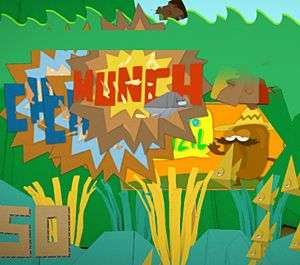 Score-attacking isn’t the be-all and end-all; each act contains several levels that take a break from the previously established formula, asking you to reach the exit in record time for medallion-related glory, destroying a M.E.A.N Corp structure in a relatively easy puzzle section, or taking on a monster of the deep in what can be loosely described as a boss fight. There’s plenty of variety in these proceedings, but some stages can end up feeling little more than filler, especially the M.E.A.N sections; considering that their actions kick-start the plot, their sections are disappointingly short, and, as they’re the only levels where it’s impossible to die, there’s no real rush to act, making them at best too serene and at worst anti-climatic and lacking in impact. Similarly, the boss sections seem included more to tick a box – there’s no stated purpose of attacking and eating them – and can feel a little clumsy.
Score-attacking isn’t the be-all and end-all; each act contains several levels that take a break from the previously established formula, asking you to reach the exit in record time for medallion-related glory, destroying a M.E.A.N Corp structure in a relatively easy puzzle section, or taking on a monster of the deep in what can be loosely described as a boss fight. There’s plenty of variety in these proceedings, but some stages can end up feeling little more than filler, especially the M.E.A.N sections; considering that their actions kick-start the plot, their sections are disappointingly short, and, as they’re the only levels where it’s impossible to die, there’s no real rush to act, making them at best too serene and at worst anti-climatic and lacking in impact. Similarly, the boss sections seem included more to tick a box – there’s no stated purpose of attacking and eating them – and can feel a little clumsy.
Conversely, the time trial sections fit snugly into the gameplay and feel like a natural extension of such, requiring you to use the skills you’ve learnt throughout to race through and go for gold. Acquiring shiny glory doesn’t require you to be pitch-perfect either, and with maybe one exception, you’re able to make a mistake or two and still come out top, rather than be punished heavily for every discrepancy. If you ignore that they’re oddly placed in a tale about revenge, then they’re often the most fun part of the experience.
I know it’s not supposed to be all about the narrative, but Derrick the Deathfin feels like a wasted storytelling opportunity; destroying M.E.A.N operations also involves a large amount of collateral damage, and the leaking oil and toxic waste you leave in your trail are simply ignored. Similarly, there could have been some justification for why the titan fish wanted you gone, or a hinted consequence as to what happens when you eat everything in your path in the name of vengeance. When your plot and character justification involve trying to take down the corporation that killed your family and are destroying the environment it feels like a massive own goal to wipe out most of the underwater population and cause environmental disasters and never address that. The final act involves you blowing up the last construction by those who made your parents into tuna (sharks aren’t even made into tuna! What’s the deal with that?), then you still have four more missions of munching down fish until the story finishes. It doesn’t impact the overall quality, but even an extra line could have given a great undercurrent as to the true implication of your actions.
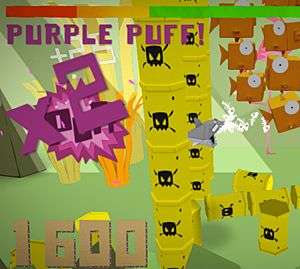 What does impact the game as a whole are the controls. Derrick is only controlled with the left control stick, the go-faster button (R2) and the eat and also jump again in midair button (O), and though their placement feels natural your actual movements within the fictional space are not. Though the left control stick has 360 degrees of movement, the Deathfin doesn’t, causing a level of imprecision that will start to grate before too long. Starting as a mild irritation when eating all of the surrounding fish takes a few seconds longer than it should – when those vital seconds could mean the difference between Derrick living or the level resetting, thanks to the ever-decreasing health-bar – it builds up when you’ve had to restart a level repeatedly because you couldn’t get the right angle on a vital jump, can’t activate the mid-air jump or because your attempts to eat saw you smacking into the scenery once too often.
What does impact the game as a whole are the controls. Derrick is only controlled with the left control stick, the go-faster button (R2) and the eat and also jump again in midair button (O), and though their placement feels natural your actual movements within the fictional space are not. Though the left control stick has 360 degrees of movement, the Deathfin doesn’t, causing a level of imprecision that will start to grate before too long. Starting as a mild irritation when eating all of the surrounding fish takes a few seconds longer than it should – when those vital seconds could mean the difference between Derrick living or the level resetting, thanks to the ever-decreasing health-bar – it builds up when you’ve had to restart a level repeatedly because you couldn’t get the right angle on a vital jump, can’t activate the mid-air jump or because your attempts to eat saw you smacking into the scenery once too often.
In the later stages, this unreliability is compounded by the addition of fish that can bite back and level design that requires you to make precise jumps and movements if you want to see the finishing line. The retaliating fish become an even greater nuisance when you consider the fact that confrontation with more than one or two at any time can often send you back to the starting line again, as most attackers can hit you thrice before you’re able to react to the first strike. Being struck by an enemy, attempting evasive manoeuvres and being wiped out before the shark reacts to your command is an all-too common occurrence that would be easily negated by a temporary invulnerability mechanic, or lessened by a reduction in the amount of health they can knock out of you or more precise movement from your playable character. Some of the more problematic stages will simply throw a swarm of these enemies at you in order to artificially inflate the difficulty in lieu of more inventive design, and it’s easily possible to mess up due to the imprecise controls, be set upon by electric eels and be made to restart within seconds.
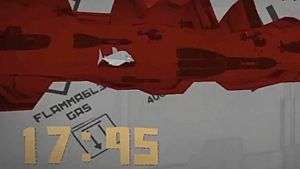 It’s a shame, because until the final act these problems only act in isolation and can be pushed to the side, but once you hit the Arctic all of these elements combine and raise the bar to the point where fun is swapped for frustration and attrition replaces amusement. The controls are such a fundamental aspect that repeated failures appear more like the game’s fault than yours, especially when success starts to feel flukey as you managed to nail that jump, with no idea how you managed it this time, but couldn’t those other twenty times.
It’s a shame, because until the final act these problems only act in isolation and can be pushed to the side, but once you hit the Arctic all of these elements combine and raise the bar to the point where fun is swapped for frustration and attrition replaces amusement. The controls are such a fundamental aspect that repeated failures appear more like the game’s fault than yours, especially when success starts to feel flukey as you managed to nail that jump, with no idea how you managed it this time, but couldn’t those other twenty times.
After overcoming the odds, besting the M.E.A.N Corporation and leaving an army of aquatic skeletons in your wake, you’ll find that your adventures end far quicker than you’d think; you’ll see everything Derrick the Deathfin has to offer within an afternoon, although there’s some longevity in trying to collect all of the gems, jumping through all the burning tyres and attaining gold in every level if you’re a trophy-hound or a completionist. Your adventure feels like a quick excursion than an extended stay, and you’ll zip through thanks to the mechanics essentially forcing you to move through at breakneck speeds rather than soak up the environments.
It’s almost a crime you have to do so, as the highlight of the experience is undoubtedly the beautiful paper-craft art-style – every environment, character and object is rendered in it and it helps make this release stand out amongst so many others, with a distinctive charm that can raise a smile with just a glance. It effortlessly fills the world with a distinctive personality, but can feel under-appreciated thanks to the fact that you’re encouraged to zip through each level if you don’t want to end up as fish food. It’s almost worth revisiting levels alone just to soak up their atmosphere, because it’s where this title shines most resolutely. Conversely, the music is mostly forgettable with the exception of the warning music as Derrick’s health-bar reaches the low and critical stages, raising the tension and panic levels as you attempt to keep him as a swimmer, not a floater.
There was plenty of potential to be had in Derrick the Deathfin – it’s a wonderful looker with a great deal of charm, variety and a style of play that makes it easy to pick up but harder to master. Unfortunately, this is all eventually marred by a lack of precise controls, balanced difficulty in the late stages and overall content. Rather than emerge as a big fish in a small pond, it may ultimately end up as a drop in the ocean.
Pros- Beautiful and unique paper-craft graphics likely to find a large plaice in your heart
- Easy to pick up and varied gameplay may hook you
- The quest for completion will reel you in
- You'll eventually tuna out the music
- Loose, imprecise controls may inspire (crocodile) tears
- Later stages go off the deep-end
- You'll batter the content in an afternoon
- I ran out of puns
Derrick the Deathfin is a charming game that should have stayed afloat thanks to its great ideas and amazing art-style, but due to poor controls and occasionally poor level-design, it ultimately sinks along with this metaphor.
Last five articles by Edward
- Best of 2015: Journey's End: A New Beginning
- Journey's End: A New Beginning
- You Can't Choose Your Happy Ending
- Okay, Let's Fix Comedy In Games - The V-Effekt
- Time Keeps On Smashing Away















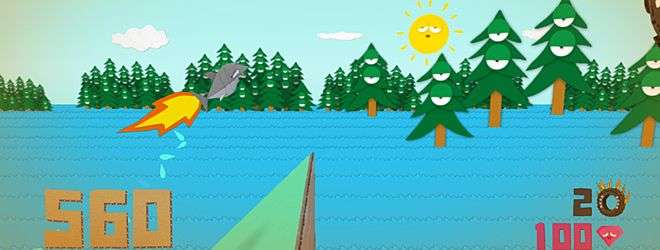
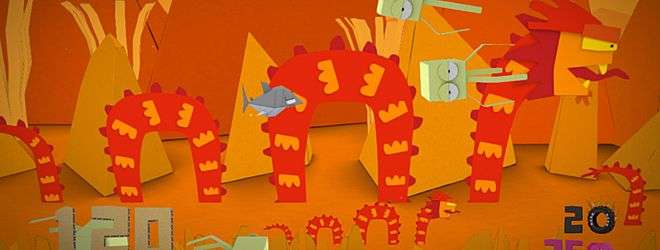
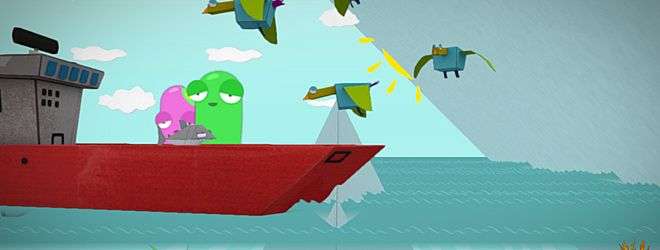






Brilliant review, Ed!